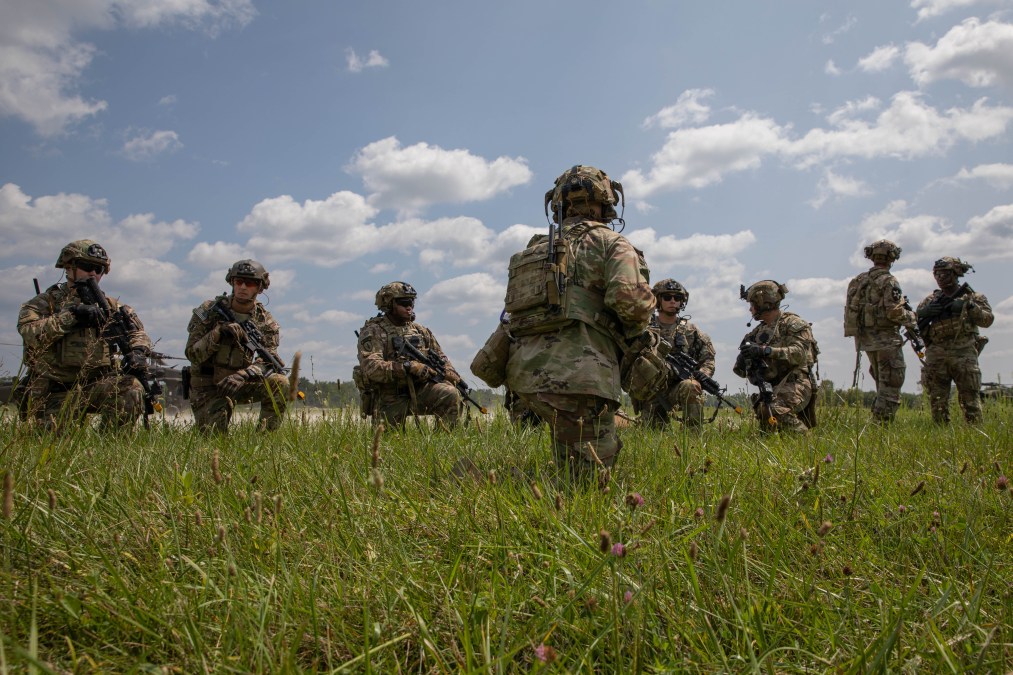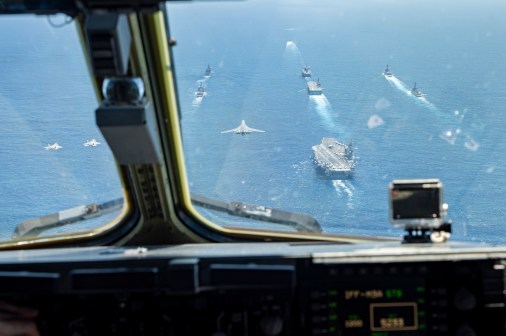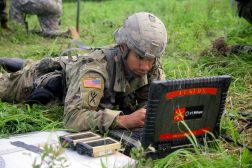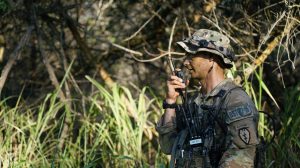Army looking to industry to provide options for mobile command posts

SAVANNAH, Ga. — The Army is altering its approach for a key program designed to make units faster on the battlefield.
The Command Post Integrated Infrastructure (CPI2) initiative aims to make command posts more mobile and survivable.
The Army had previously outlined contracts for CPI2 to initially be built on Family of Medium Tactical Vehicles variants, which are very large. Now, it’s scaling that back.
“Our CPI2 program and our command post capabilities that we’ve built, which is today FMTV [expandable] van, really at the halt or at the stop sort of planning function — how do I get my staff elements together, how do I build a robust network? What we’d like to do over the next year or two is build more modular and tailorable command posts,” Mark Kitz, program executive officer for command, control, communications-tactical, told DefenseScoop at the Army’s Technical Exchange Meeting Dec. 12 in Savannah, Georgia.
As adversaries have proven adept at finding and targeting units on the battlefield, one of the Army’s top modernization initiatives, dubbed command-and-control on the move, aims to ensure units are more mobile, faster and require less time to establish connectivity.
“Since the global war on terror, the Army has pivoted to large-scale combat operations and what does it mean to do C2 on the move and how critical it is to enable large-scale combat operations,” Col. Matt Paul, project manager for mission command at PEO C3T, told DefenseScoop at the Technical Exchange Meeting.
The directed requirement from the Army focuses on mobility as the chief mechanism for survivability, meaning that going forward, command posts must be designed to most fast while establishing communications.
“What we’ve learned from the experimentation is that we can make strides in improving mobility, we can make strides in helping organizations through the integrated infrastructure in place, and displace faster and provide commanders and staffs more opportunities to tailor their command post as needed,” Col. Charles Ford, Army capability manager for mission command/command post, who is in charge of requirements, told DefenseScoop. “The next steps for us … is that we’re actually doing a single concept of employment that looks at the C2 system holistically. And then from that, we want to then start drafting what we think an updated requirements document would look like.”
Kitz said the Army recently released a request for information to industry asking for options on modularity of command posts so that it’s not just an FMTV establishing communications at the halt.
The plan is to release a request for proposals with the intent to award next year for a competitive prototyping effort on modular approaches with dispersed, more survivable options for CPI2, Kitz said.
The Technical Exchange Meeting is allowing the Army to meet with many companies one-on-one and provide them with a blank slate to help the service pave the way ahead.
In fact, this eleventh Technical Exchange Meeting is the first such event where the Army actually brought hardware for vendors to see and provide ideas.
“Here in the TEM, we actually have some hardware, we have a [joint light tactical vehicle] configured for at the quick halt, so that you don’t have to set up a tent, that you can do collaboration right internal to your JLTV,” Kitz said. “We’re already starting some of that experimentation, but [for] our on-the-move experimentation we’re going to leverage some of the work that the Marines have done. They’ve done a lot of experimentation with the on-the-move command posts.”
The Army hopes to actually start experimenting in third quarter of this fiscal year regarding CPI2.
There have already been a series of experiments focused on solutions for on-the-move comms for armored units — a difficult challenge given those platforms have significant size, weight and power concerns. Another follow-on pilot is planned for fourth quarter of this fiscal year.
Tailoring for units
Essential to enabling command-and-control on the move is allowing units to tailor capabilities based on their needs.
I Corps, based in the Pacific, for example, has units with multiple command posts on multiple island chains leading to huge dispersion and creating challenges for targeting and collaboration, Kitz said, as compared to units in Poland that might have more condensed command posts at the halt doing planning and pre-positioning.
“CPI2, that hardstand, is one option for commanders. Another option might be inside their Stryker brigade, they have a more robust tactical network or they have a more robust way of at the stop, at the quick stop, setting up,” he said. “What we’d like to do over the next year with industry … and some operational units — is [figure out] how do we get to this modular command post — whether it’s dismounted off my tactical vehicle, whether it’s at the quick halt, or whether that’s purely on the move — how do I give them a robust capability to do that?”
This doesn’t mean creating distinct networks and solutions for each unit type, which becomes infeasible and creates significant interoperability and sustainment concerns. Rather, it is a family-of-systems solution.
“What we need to do is just have like almost like your family-of-terminals design. We need a family of command post kits, for lack of a better term, that can then be mounted in a family of vehicles,” Matt Maier, project manager for interoperability, integration and services at PEO C3T, told DefenseScoop.
This family-of-systems commonality approach, however, requires collaboration across the entire Army to include the platform community to ensure communications equipment will fit and won’t overload the power on vehicles — an issue the Army has encountered previously.
New initiatives such as open systems architectures is helping to solve that. The Army in 2025 will be starting a program of record dubbed Command, Control, Computers, Communications, Cyber, Intelligence, Surveillance and Reconnaissance (C5ISR)/Electronic Warfare (EW) Modular Open Suite of Standards (CMOSS) Mounted Form Factor, or more simply, CMFF. That program will essentially provide a common chassis on all vehicles in which electronic gear and equipment will simply be loaded on with a card.
“The goal would be to have a series of command post systems that include mission command, that include transport, that include some kind of bandwidth virtualization type functionality. Probably include some kind of a lower tier stuff, … radios even, so that we can have dismount capability, all those in a package. Then we would slot that into a common A-kit architecture on actual vehicles, whether it’s Stryker or [Armored Multi-Purpose Vehicle] or JLTV,” Maier said.
This will enable the Army to swap new capabilities much easier and faster.
“Every platform is different. Strykers got dozens of variants. JLTV. It’s different every time. That limits us from a pivot [and] speed perspective. Our ability to go fast — integrations is our” limiting factor, Paul said.
The new approach will allow Army units to be more flexible because they can mix and match and plug and play with capabilities depending on their missions.
“Different formations may get slightly different solution. They get the same box, but what cards they have inside their box may be a little bit different based on their mission and the unit type and what they’re going to go do,” Paul said. “They may not need an [electronic warfare] card because there’s no EW threat. Take the card out, put another radio card in there, whatever. It offers the commonalities with tailorability. It offers modularity, plug and play, and you only have to integrate once. It’s like you set it and forget it. Then you don’t have to worry about power.”
Spectrum concerns
Chief among the Army’s command post concerns deals with how units emit and can be found within the electromagnetic spectrum.
One of the service’s major takeaways from Russia’s 2014 invasion of Ukraine, was Russian forces’ ability to locate Ukrainian command posts and fire upon them, just based on their electronic signatures.
The Pentagon’s Russia New Generation Warfare study in 2017 spurred several modernization efforts still ongoing today to improve signature management, reduce the size and complexity of command posts, and develop better electronic countermeasures and jamming capabilities.
To best enable units’ command posts to be on the move, mobile and survivable, they need to understand what their footprints in the spectrum looks like and have the ability to deceive adversaries of those footprints.
Two new programs aim to do just that. One is Spectrum Situational Awareness System (S2AS), a new start for 2025 for Program Executive Office Intelligence, Electronic Warfare and Sensors, which will provide sensing and visualization of what units look like in the spectrum.
“It allows you to kind of see, in near real-time, what you look like, how you’re being affected by friendly [forces], how you’re being affected by enemy, coalition, ISR assets, and all that,” Brig. Gen. Wayne “Ed” Barker, program executive officer for IEW&S, told DefenseScoop.
The other program is Modular Electronic Spectrum System (MEMSS), a new start slated for the 2026 time frame, which supports command post survivability through employing techniques in the spectrum to confuse and deceive adversaries while also disrupting their targeting cycles.
“It goes back to understanding how you look and are there ways to lower or raise noise levels to better hide in plain sight,” Barker said of MEMSS.
MEMSS, which stems from an earlier science-and-technology effort dubbed Modular Electromagnetic Spectrum Deception Suite, could leverage inexpensive, disposable decoys or small emulators to replicate the footprint of a series of radios or even a command post in the spectrum, Barker said.






